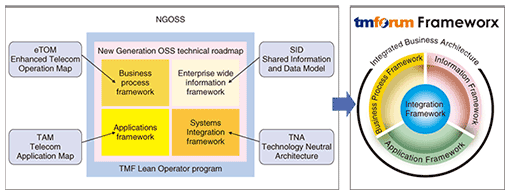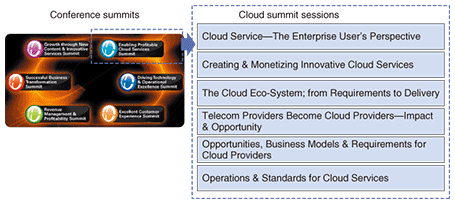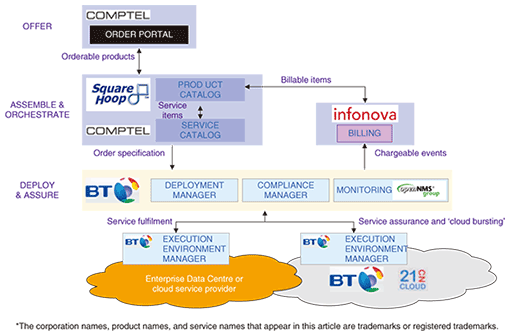 |
|||||||||||||||||||
|
|
|||||||||||||||||||
|
Global Standardization Activities Vol. 9, No. 2, pp. 75–79, Feb. 2011. https://doi.org/10.53829/ntr201102gls TeleManagement Forum Standardization Trends at Management World 2010AbstractThis article reports the most recent standardization trends in the TeleManagement Forum (TM Forum), such as the Frameworx integrated business architecture and the user-led cloud study group Cloud Service Initiative (CSI) as well as the latest trends seen at Management World 2010 in May.
1. Overview of TM ForumThe TeleManagement Forum (TM Forum) [1] is a non-profit industrial organization established to study industrial standards and promote their widespread adoption and application to actual products. The objective is information and communication system network management that enables interoperability. Since its founding in 1988, membership has increased continuously. As of September 2010, there were over 700 member corporations from 195 countries. They include NTT, AT&T, BT and other carriers that are top-ranked in sales and Ericsson, Huawei, Nokia Siemens, and other major communication equipment vendors. TM Forum standardization activities have been moving forward, with studies centered on New Generation Operation Systems and Software (NGOSS) [2]. Enterprise members have been promoting standards that are better aligned with reality by developing an operation management system based on the industrial standards that are being studied and providing feedback on problems. The value of the eTOM (enhanced Telecom Operations Map) framework for comprehensive organization of service provider business processes, a part of NGOSS, has also been recognized in ITU-T (International Telecommunication Union, Telecommunication Standardization Sector), and ITU-T’s M.3050 series Recommendations have adopted the eTOM document. Each year in May, the TM Forum hosts an event called Management World. It includes conferences and exhibitions related to business and technology trends in the telecommunications industry. 2. Standardization trends2.1 FrameworxA new undertaking in recent TM Forum standardization is the study of Frameworx [3], which is positioned as the successor to the existing NGOSS. Frameworx provides a service-oriented integrated business architecture that subsumes the NGOSS frameworks. This is considered to be an important factor in a market that requires rapid provisioning of new services, given the severe competition in which service providers operate. Frameworx basically appropriates the NGOSS components listed below.
As shown in Fig. 1, the Technology Neutral Architecture (TNA), which is the system integration framework in NGOSS, is used. However, when TNA was established, it was not based on service orientation, so some people think that it will not provide sufficient speed and flexibility in service construction. Therefore, the Frameworx Integration Framework focuses on the construction of a service-oriented architecture and emphasizes flexible interworking among business processes, information and applications, and the rapid development of business service categories.
To promote the development of Frameworx-compliant solutions, the TM Forum also plans to perform implementation support, solution product compliance certification, certification training, TM Forum certification partnership programs, and other such activities for service providers. 2.2 Cloud servicesIn existing standardization activities related to cloud services, the main target of most standards organizations is maintaining the interconnectability of the cloud infrastructure through infrastructure as a service (IaaS). Thus, a major feature is that the establishment of standards is led by vendors (Table 1). On the other hand, the TMF cloud study group, Cloud Service Initiative (CSI), considers that cooperation between users and vendors, particularly to clarify service requirements on the user side, is essential for widespread use of cloud services. Therefore, CSI has established the Enterprise Cloud Leadership Council (ECLC) [4] to strengthen the cooperative relationship between users and vendors and begin studies on cloud standards that focus on users’ requirements, including benchmarking, i.e., performance testing (Fig. 2).
The participants in ECLC include enterprise users such as Deutsche Bank in addition to vendors (Alcatel-Lucent, CA, Cisco, EMC, HP, IBM, Microsoft, Nokia Siemens Networks, etc.) and carriers (AT&T, BT, Telecom Italia, etc.). ECLC’s approach includes fostering a worldwide market for an effective and efficient cloud infrastructure, accelerating standardization of cloud services to define the best common processes for providing the best services, and achieving transparency in costs and service level by means of an ecosystem. ECLC plans to release two white papers by the end of 2010: Database as a Service White Paper and Private Cloud Reference Architecture White Paper. Other projects include setting up a Private Cloud Catalyst working group, setting vendor benchmark criteria, and defining a category for interfacing with vendors. Particular effort is going into the Private Cloud Reference Architecture White Paper, with the study proceeding on the premises listed below.
In May 2010, Sean Kelley from the Deutsche Bank Platform Services Group was appointed to chair ECLC, which strengthens ECLC’s ability to deal with user requirements in the field of banking. 3. Latest trends at Management World 2010Management World 2010*1 [5] was held on May 18–20, 2010 in France and was attended by 3000 participants from 81 countries. The main topic was “Clouds on the Horizon?” There were six keynote speech topics, six conference summit topics, and seven Forumville demonstration topics. 3.1 Keynote speechesThe six keynote speeches fell into two styles: there were four panel discussions and two presentations. (1) Operation of an all-IP network (2) Managed services (3) The customer experience (4) Mobile commerce (5) Cloud (6) Cost reduction The presentation “Cloud: the new business model for tomorrow’s world” attracted great interest. It was conducted in a panel discussion style and focused on how cloud users and providers can work together on cloud business model construction and popularization in a cloud era. In the discussion, the importance of rapid flexible service customization and introduction by the cloud provider from the standpoint of user benefits was emphasized. The transparency and migratability of services and the standardization of security were also discussed as prerequisites for future widespread adoption of cloud services. Furthermore, the speakers all expressed their expectation that future TM Forum cloud standardization activities will expand the application area of cloud services that can be used without anxiety by further strengthening the cooperative relationship between users and vendors and by clarifying the user-side requirements. 3.2 Conference summitsThe conference was divided into six summits, and the cloud summit was further divided into six sessions (Fig. 3). Of the cloud sessions, two in particular attracted great interest from the participants. They included presentations from major enterprises that represent cloud service users and providers (Deutsche Bank, IBM, etc.) on the topics of users’ requirements and earnings model & introduction. The contents of these two sessions are summarized below.
(1) Cloud Service—The Enterprise User’s Perspective Deutsche Bank presented “Cloud as a Business Game Changer”, which explained cloud requirements from the enterprise user’s viewpoint. The cloud services needed by banks must satisfy mission-critical-grade requirements, including security, reliability, control, self service, economy, abstraction, and standardization. It was emphasized that standardization is particularly important to the user and essential for eliminating concern about vendor lock-in and allowing service selection and use. (2) Creating & Monetizing Innovative Cloud Services The IBM presentation on “Moving Your Cloud-Based Services Business from Concept to Reality” explained cloud business modeling and construction. The cloud market is divided into the three submarkets: business services, infrastructure services, and component supply. The market scale is expected to reach US$126 billion by 2012 according to surveys by consulting companies. Many enterprises are currently attempting to utilize their assets in order to become cloud providers, but SWOT analysis*2 and clarification of the emerging market are needed. Furthermore, it was advised that a company should conduct in-house trials to develop expertise on construction and operation before offering the service to others. 3.3 ForumvilleForumville provides a place for exhibiting experimental products that feature the standards promoted by the TM Forum. It was set up to demonstrate the utility of the standards and encourage adoption. The Forumville of Management World 2010 involved exhibits on seven subjects, including cloud services. (1) Cloud services (2) Business transformation (3) Revenue management and mobile commerce (4) Customer experience and business intelligence (5) Digital media (6) Technology and operations (7) Defense Of those, the Cloud Service Broker [6] demonstration, developed at the request of BT, drew great attention as an example of cloud service development by a carrier. The Cloud Service Broker is a tool that provides a management interface between the enterprise user and the cloud service environment (Fig. 4). It enables enterprise users to control cloud services according to their own governance policies and to visualize service performance, security, cost management, and other such aspects of operations.
4. ConclusionCloud services were a major part of Management World 2010. This article reported on the presentations and demonstrations related to cloud services and on ECLC standardization activities. The cloud market is expected to continue to expand in the future, following the evolution of standardization activities. NTT Comware is paying close attention to the studies of Frameworx and cloud services that were actively discussed at Management World, continuously keeping up with telecommunications industry trends in various countries and, as a member of the NTT Group, moving forward with activities that promise to raise the presence of Japanese enterprise in the TM Forum. References
|
|||||||||||||||||||













